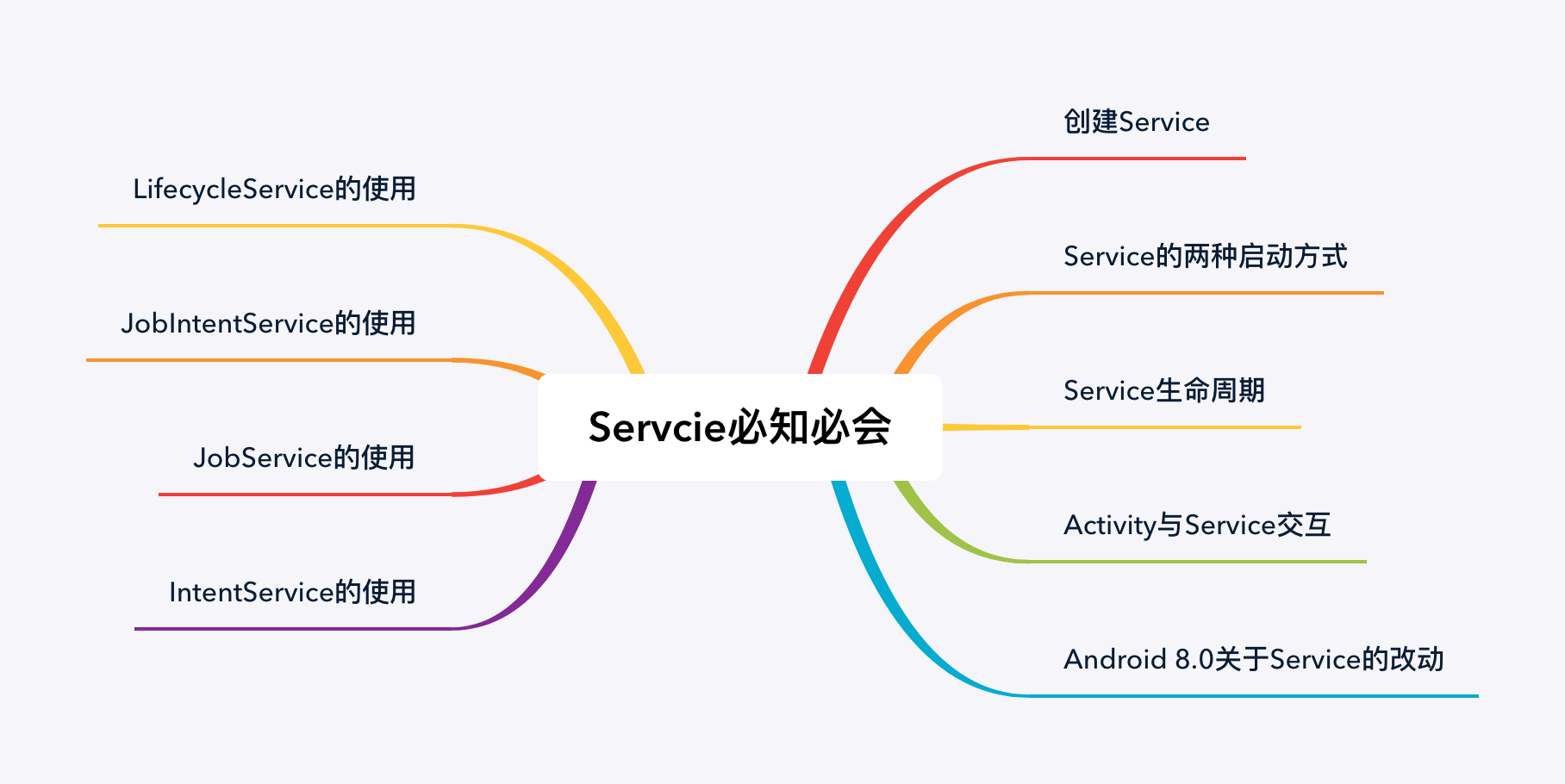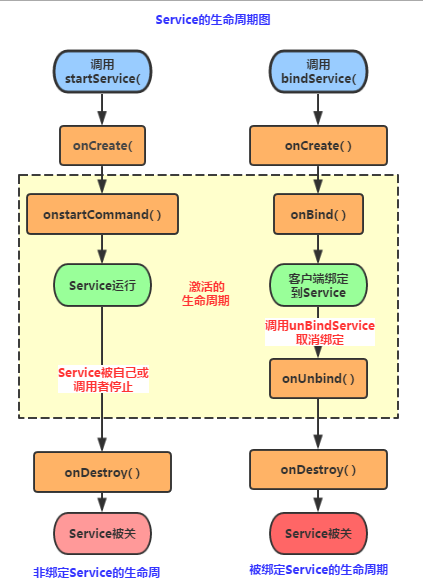Service 必会必知
Service服务是Android四大组件之一,是Android提供的一种的 不需要和用户交互,且需要长期运行任务的解决方案。
Service启动后默认是运行在主线程中,在执行具体耗时任务过程中要手动开启子线程,应用程序进程被杀死,所有依赖该进程的Service服务也会停止运行。
[!TIP|style:flat]
Service是四大组件之一,同样需要在AndroidManifest中注册后,才能使用.

Service启动方式与生命周期
Service启动方式分为两种,普通启动startService 、绑定启动bindService

普通启动startService()
①首次启动会创建一个Service实例,依次调用onCreate()和onStartCommand()方法,此时Service 进入运行状态
②如果再次调用StartService启动Service,将不会再创建新的Service对象, 系统会直接复用前面创建的Service对象,调用它的onStartCommand()方法!
③这样的Service与它的调用者无必然的联系,就是说当调用者结束了自己的生命周期, 但是只要不调用stopService,那么Service还是会继续运行的!
④无论启动了多少次Service,只需调用一次StopService即可停掉Service
- 定义Service服务
class TestService : Service() {
private val TAG = "TestService1"
//必须要实现的方法
override fun onBind(intent: Intent?): IBinder? {
Log.e(TAG, "onBind方法被调用!")
return null
}
//Service被创建时调用
override fun onCreate() {
Log.e(TAG, "onCreate方法被调用!")
super.onCreate()
}
//Service被启动时调用
override fun onStartCommand(intent: Intent?, flags: Int, startId: Int): Int {
Log.e(TAG, "onStartCommand方法被调用!")
return super.onStartCommand(intent, flags, startId)
}
//Service被关闭之前回调
override fun onDestroy() {
Log.e(TAG, "onDestory方法被调用!")
super.onDestroy()
}
}
- AndroidManifest.xml完成Service注册
<application>
<service android:name=".components.TestService1">
</service>
</application>
- 在Avtivity中StartService启动服务
val intent = Intent(this,TestService1::class.java);
startService(intent);
- 日志输出与结果分析
TestService1: onCreate方法被调用!
TestService1: onStartCommand方法被调用!
TestService1: onStartCommand方法被调用!
TestService1: onStartCommand方法被调用!
TestService1: onStartCommand方法被调用!
TestService1: onDestory方法被调用!
从上面的运行结果我们可以验证我们生命周期图中解释的内容: 我们发现onBind()方法并没有被调用,另外多次点击启动Service,只会重复地调用onStartCommand 方法!无论我们启动多少次Service,一个stopService就会停止Service!
绑定启动bindService()
①当首次使用bindService()启动一个Service时,系统会实例化一个Service实例,并调用其onCreate()和onBind()方法,然后调用者就可以通过返回的IBinder对象和Service进行交互了,此后如果我们再次使用bindService绑定Service,系统不会创建新的Sevice实例,也不会再调用onBind()方法,只会直接把IBinder对象返回给调用方
②如果我们解除与服务的绑定,只需调用unbindService(),此时onUnbind和onDestory方法将会被调用
③bindService启动的Service服务是与调用者(Activity)相互关联的,可以理解为 "一条绳子上的蚂蚱",要死一起死,在bindService后,一旦调用者(Activity)销毁,那么Service也立即终止
- 定义Service服务
class TestService2 : Service() {
private val TAG = "TestService2"
private var count = 0
private var quit = false
//定义onBinder方法所返回的对象
private val binder: MyBinder = MyBinder()
inner class MyBinder : Binder() {
fun getCount(): Int {
return count
}
}
//必须实现的方法,绑定改Service时回调该方法
override fun onBind(intent: Intent?): IBinder {
Log.e(TAG, "onBind方法被调用!")
return binder
}
//Service被创建时回调
override fun onCreate() {
super.onCreate()
Log.e(TAG, "onCreate方法被调用!")
//创建一个线程动态地修改count的值
object : Thread() {
override fun run() {
while (!quit) {
try {
sleep(1000)
} catch (e: InterruptedException) {
e.printStackTrace()
}
count++
}
}
}.start()
}
//Service断开连接时回调
override fun onUnbind(intent: Intent?): Boolean {
Log.i(TAG, "onUnbind方法被调用!")
return true
}
//Service被关闭前回调
override fun onDestroy() {
super.onDestroy()
quit = true
Log.i(TAG, "onDestroyed方法被调用!")
}
override fun onRebind(intent: Intent?) {
Log.i(TAG, "onRebind方法被调用!")
super.onRebind(intent)
}
}
- AndroidManifest.xml中注册服务
<application>
<service android:name=".components.TestService2">
</service>
</application>
- 在Activity中bindService启动服务
//保持所启动的Service的IBinder对象,同时定义一个ServiceConnection对象
val conn: ServiceConnection = object : ServiceConnection {
//Activity与Service断开连接时回调该方法
override fun onServiceDisconnected(name: ComponentName) {
println("------Service DisConnected-------")
}
//Activity与Service连接成功时回调该方法
override fun onServiceConnected(name: ComponentName, service: IBinder) {
println("------Service Connected-------")
binder = service as MyBinder
}
}
// bind服务
val intent = Intent(this,TestService::class.java)
bindService(intent,conn,Context.BIND_AUTO_CREATE)
start_service.setOnClickListener {
// 从服务获取数据
Log.e("TestService2","getCount:${binder?.getCount()}")
}
// 停止按钮
stop_service.setOnClickListener {
unbindService(conn)
}
- 日志输出与结果分析
TestService2: onCreate方法被调用!
TestService2: onBind方法被调用!
TestService2: ------Service Connected-------
TestService2: getCount:4
TestService2: getCount:6
TestService2: getCount:9
TestService2: onUnbind方法被调用!
TestService2: onDestroyed方法被调用!
使用BindService绑定Service,依次调用onCreate(),onBind()方法, 我们可以在onBind()方法中返回自定义的IBinder对象;再接着调用的是 ServiceConnection的onServiceConnected()方法该方法中可以获得 IBinder对象,从而进行相关操作;当Service解除绑定后会自动调用 onUnbind和onDestroyed方法,当然绑定多客户端情况需要解除所有 的绑定才会调用onDestoryed方法进行销毁哦
Android 8.0及以上不允许后台启动Service服务
在一加手机上,用户升级了新版8.0的系统,用户将app切到后台,过一会儿就弹出“xxx app 已停止运行”的弹窗。
通过定位分析,发现下面俩前置条件
- 8.0系统杀服务杀的很频繁
- 为了保活,我们使用了俩Service互保的方式
马上跑了26的模拟器,果然复现,日志如下:
Process: com.example.firstapp, PID: 10510
java.lang.IllegalStateException: Not allowed to start service Intent { cmp=com.example.firstapp/.components.TestService }: app is in background uid UidRecord{adece9d u0a77 LAST bg:+1m35s61ms idle procs:1 seq(0,0,0)}
at android.app.ContextImpl.startServiceCommon(ContextImpl.java:1505)
at android.app.ContextImpl.startService(ContextImpl.java:1461)
at android.content.ContextWrapper.startService(ContextWrapper.java:644)
at android.content.ContextWrapper.startService(ContextWrapper.java:644)
at com.example.firstapp.components.TestServiceActivity$onCreate$1.run(TestServiceActivity.kt:26)
我查阅了android官网,有如下一段描述:
Android 8.0 还对特定函数做出了以下变更:
- 如果针对 Android 8.0 的应用尝试在不允许其创建后台服务的情况下使用
startService()函数,则该函数将引发一个IllegalStateException。- 新的
Context.startForegroundService()函数将启动一个前台服务。现在,即使应用在后台运行,系统也允许其调用Context.startForegroundService()。不过,应用必须在创建服务后的五秒内调用该服务的startForeground()函数。
解决方法就很简单了,把Service互启的逻辑块改为:
- AndroidManifest.xml声明权限
<uses-permission android:name="android.permission.FOREGROUND_SERVICE" />
- 服务启动兼容写法
if (Build.VERSION.SDK_INT >= 26) {
context.startForegroundService(intent);
} else {
// Pre-O behavior.
context.startService(intent);
}
class TestService:Service(){
// 发送一个前台通知
override fun onCreate(){
val notification: Notification =Notification.Builder(applicationContext, "channel_id").build()
startForeground( 1, notification)
}
}
在被启动的Service创建服务后的五秒内调用startForground(0, new Notification()),如果不调用或调用时间超过5秒会抛出一个ANR。